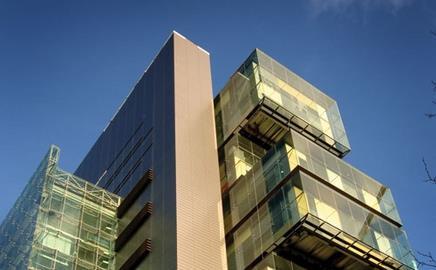Phil Cook of Euroclad explains how his company is reacting to rapid changes in the market, and why metal cladding is on the up and up.
Founded in Cardiff in 1981, Euroclad has become the UK’s largest independent supplier of profiled steel and aluminium building envelopes. It has 220 employees and turned over £32m last year from roofing and cladding. Focusing on the cladding side of the business, managing director Phil Cook tells us about rapid changes in the industry, product development and some of the high-tech projects he has worked on.
Q: Describe your market
A: Metal cladding has undergone a transformation in the past 10 years. In the eighties and nineties, the market was mainly for industrial buildings. Since then it’s moved into schools, hospitals, leisure, retail and residential – and the increase has been dramatic. The speculative building market has declined. So it’s lucky that the market is expanding elsewhere.
The transition from traditional to metal-clad buildings has come about on the back of the 1991-92 recession, when the total cladding market dropped 60%. Many quite traditional architects left the industry. But the new architects coming through in the nineties weren’t so restrictive. They understood the thermal, airtightness and acoustic benefits of metal. It’s also flexible, demountable and can be easily recycled.
Metal cladding for leisure centres is commonplace now and residential developments are coming along too. This wouldn’t have been the case 10 years ago. Before the recession, our turnover was £16m so we’ve come a long way.
Q: Is it a competitive market?
A: Extremely – it keeps me occupied 12 hours a day. Direct competitors in the metal cladding and single-ply membrane makers include Corus and Kingspan. But other envelope materials, such as slates and blocks, are still significant competition.
Q: Which products are doing well?
A: All our products are buoyant, particularly in the UK, because of speed of construction, aesthetic appeal and the Building Regulations.
There’s an increasing interest in natural materials, such as stainless steel, zinc, copper, anodic aluminium and titanium. These plain metal finishes are in contrast to painted aluminium or steel.
Our trapezoidal and sinusoidal profiled, built-up systems are also becoming more popular, because they have a low carbon footprint when compared with composite panels. They’re a particularly popular choice for big sheds. Marketed as Elite Systems, they contain mineral wool kept apart by metal spacers, rather than foam, which we don’t use because it contains greenhouse gases and has higher embodied energy.
Our other significant range comes under the banner of Linear Systems and includes rainscreens and other facades.
It’s hard to break down our products into anything more specific because usually an architect will come to us, say that it wants to use metal and set several parameters relating, for example, to fire. Then we go away and help design something around these requirements.
Q: In which high-profile jobs have your products been used?
A: Manchester Civil Justice Centre is a high-tech example. We supplied 8,000m2 of metal rainscreen facade. The building is hugely tall, avant-garde and so complex that it looks like something a six-year-old might have built with Lego. We have also been involved with the O2 stadium. The cladding for this is curved in two planes so it has complex geometry. We built it with 95 5m long prefabricated sections of facade from aluminium and composite materials.
No two sections are the same.
Another project of note is Cardiff’s Millennium Centre. It looks a bit like a large slug so we used our roofing, as well as cladding, products and merged the roof and walls into one continuous skin.
Q: Who has the most input into specification?
A: Architects have most input, followed by contractors. In the main, if our products are specified by name, contractors will stick to them. They know our lead times are relatively short – usually between overnight and three weeks – and that we’re competitively priced, so they have no incentive to change.
Q: What factors are having the biggest impact on product development and the sector as a whole?
A: Sustainability, recyclability, thermal performance, reducing carbon footprints – these factors all affect our products, although I don’t think anything can ever have a zero-carbon footprint.
The sector as a whole, though? God knows. A year ago I’d have said it was the move towards metal cladding in residential buildings. But the Building Regulations have already done their bit towards this. Recent changes have only assisted the growth in metal systems.
Topics
Specifier 06 July 2007
- 1
- 2
- 3
- 4
- 5
- 6
 Currently reading
Currently readingMetal arithmetic
- 7
- 8
- 9
- 10
- 11
- 12
- 13
- 14
- 15
































No comments yet